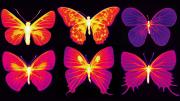To hold a delicate butterfly harmlessly, conventional wisdom advises, softly pinch its wings together. Because butterflies depend on taste receptors on their feet to find food and a suitable nest for their eggs, it’s wiser, the theory goes, to handle appendages that are only as alive as toenails or hair.
But the story is not that simple. Far from inert membranes, butterfly wings hold intricate networks of veins, sensory cells, and often scent pads for releasing and spreading mating pheromones. This winter, a collaboration between Harvard and Columbia researchers revealed just how alive these wings really are—including heat-sensing cells and tiny “wing hearts” that pump fluids through their delicate veins. And the fact that butterflies seem to use the heat sensors, and microscopic structures on their wings that reflect and radiate infrared light, to stay cool, demonstrates that much of the world a butterfly experiences involves light beyond the visible spectrum.
Hessel professor of biology Naomi Pierce, who is Harvard’s curator for Lepidoptera (moths and butterflies), met Nanfang Yu when the latter, then a postdoc, contacted her with an unusual research proposal. Yu was studying electrical engineering with Wallace professor of applied physics Federico Capasso, and had noticed that moths’ feathery antennae bore an uncanny resemblance to structures for guiding infrared light, suggesting that moths might use them to “see” light outside the visible spectrum, perhaps for finding food or mates.
Video Credit: Nanfang Yu and Jane Nisselson/Columbia Engineering
Despite some intriguing initial results (moth antennae do seem sensitive to infrared light, though whether moths react to that signal remains unclear), that initial collaboration proved less fruitful than the partnership it seeded. Ever since, Yu and Pierce have been probing how Lepidoptera sense and use light in wavelengths invisible to humans, as bees, for example, use ultraviolet patterns to pick out favorite flowers, or pit vipers use infrared wavelengths to track prey heat signatures. Yu and Pierce quickly noticed that scientists have categorized and scrutinized the patterns humans can see on butterfly wings for centuries, but surprisingly little research had examined those patterns using light outside the visible spectrum—even though there is no reason to expect butterfly patterns evolved for human eyes.
One reason for the patterns, they reasoned, could be to aid butterflies’ reactions to radiant heat: the infrared light we can feel in sunlight. Butterflies, it seems, sense heat in much the same way, carefully moving their wings to avoid overheating. In experiments, the authors observed captive butterflies taking many different steps—leaning away, side-stepping, and turning to minimize their shadows—to absorb as little radiant heat as possible.
This effect, Pierce says, is particularly pronounced in the genus Lycaena: “If you pull up images of Lycaena on the Internet, you can see every time there’s sunshine, the butterfly is minimizing its shadow. All of a sudden you start seeing things that you didn’t see before, when you think about it in terms of temperature.”
Microscopic imagery of living butterfly wings revealed one reason why they may be so sensitive to heat. The pheromone-secreting “scent pads” and sensory cells draw oxygen and nutrients from two sets of vessels carrying air and blood-like hemolymph to the wings. But where some insects make do with one tubular heart in their thorax, the hemolymph appears to need an extra push to suffuse large butterfly wings. The authors observed the regular beating of what they call a “wing heart”—often on the perimeter of the scent pad—pumping hemolymph through the veins on the wing.
Microscopic images of the most reflective wing scales revealed tubes thinner than a strand of hair...that shed excess heat as infrared light...
To understand how the wings interact with infrared light, the Pierce and Yu labs used an infrared imager developed by Yu’s graduate student Cheng-Chia Tsai to “photograph” butterfly specimens from the Museum of Comparative Zoology in infrared wavelengths. This revealed dramatic, previously invisible patterns of infrared reflection in the scales covering the wings. Microscopic images of the most reflective wing scales revealed tubes thinner than a strand of hair transfixing the scales’ layers, allowing them to shed excess heat as infrared light, and thus stay far cooler than they would otherwise. These parts of the wings, says Pierce, seem to correspond with the most “alive” parts—the scent pads, veins, and wing heart—suggesting that their high reflectance, and butterflies’ heat-avoiding behaviors, are dedicated to keeping sensitive organs cool.
It’s a result that shows that living systems can prove far more complex than what can be revealed by examining dead or “fixed” tissue, said Nipam Patel, a lepidopterist at the Marine Biological Laboratory in Woods Hole who was not involved in the study. “We always thought of these structures as passive,” he said. “We come to reasonable assumptions…but when we look at living cells, we’re often surprised.”









